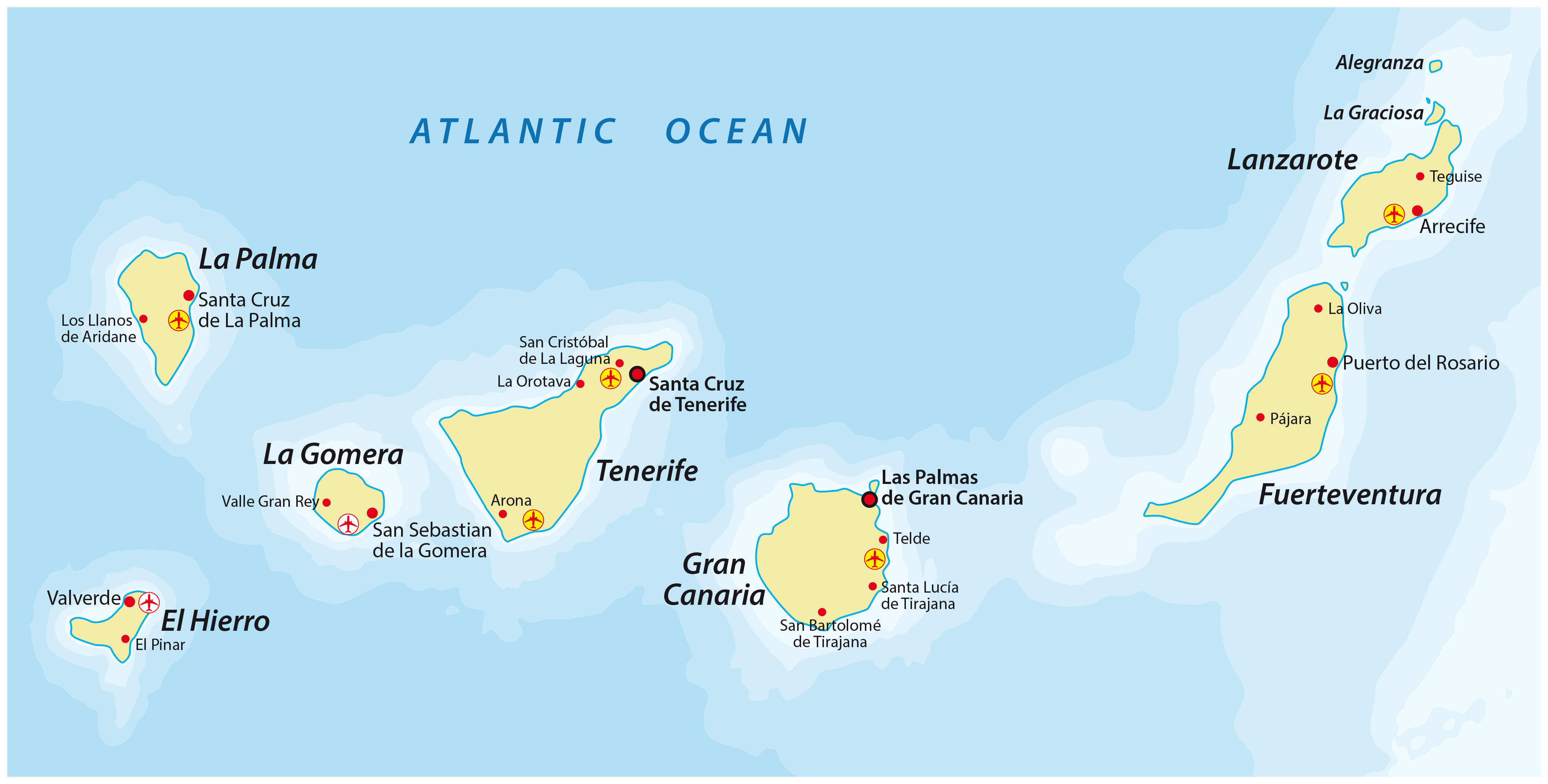Retire in the Canary Islands for Beaches and Natural Beauty
Retire in the Canary Islands for an affordable life that can be as hectic or as chill as you like. The one constant will be almost year-round mild weather.


Editor’s note: "Retire in the Canary Islands" is part of an ongoing series on retiring abroad. To see all the articles in the series, jump to the end.
First things first: Spain routinely polls as one of the most desirable countries for U.S. citizens to retire. For general information about retiring in the country, check out our article, “Retire in Spain for Rich Culture, Cuisine and Coastal Bliss.”
However, the Canary Islands are distinct.
From just $107.88 $24.99 for Kiplinger Personal Finance
Become a smarter, better informed investor. Subscribe from just $107.88 $24.99, plus get up to 4 Special Issues

Sign up for Kiplinger’s Free Newsletters
Profit and prosper with the best of expert advice on investing, taxes, retirement, personal finance and more - straight to your e-mail.
Profit and prosper with the best of expert advice - straight to your e-mail.
The Spanish archipelago with seven main islands is one of those rare southern European destinations that Americans either know a lot about (LGBT folks can’t get enough of Gran Canaria) or nothing (“Is that, like, in Africa?”).
Tourists are far more familiar with the Balearic Islands of Ibiza and Mallorca, which are plopped down in the Mediterranean off the country’s east coast, than the Canaries.

Part of that is location: Ibiza is just a 75-minute flight from Madrid. It takes more than twice as long to make it from Madrid to Tenerife, the largest Canary Island; the other major islands are Fuerteventura, Gran Canaria, Lanzarote, La Palma, La Gomera and El Hierro.
With the Canary Islands in the North Atlantic located off the African coast, they're much closer to Marrakesh than to Madrid.
Federica Grazi, who specializes in retirement relocations to Europe, says that interest in the scenic and sultry Canary Islands is on the rise.
“The Canaries are extremely open and open-minded,” she says, noting that people don’t dress to impress — and sometimes don’t dress at all. Nudity is common on the islands’ beaches. English is widely spoken.

Top two Canary Islands
Somewhat surprisingly, despite their relative remoteness, the Canary Islands are well-populated — at least, Gran Canaria and Tenerife are. More than 80% of the archipelago’s residents live on these two islands.
Grazi says that Gran Canaria and Tenerife “are the most common retirement places for expats, because they are quite beautiful and laid-back,” and though they are popular with tourists, they have proper cities where locals live and work. Grazi praises both the public transportation (buses) and the roads.
Santa Cruz de Tenerife is the capital of Tenerife; Las Palmas de Gran Canaria is the capital of Gran Canaria. Together, they are the co-capitals of the island group.
“These islands are more developed, and they offer more access, in terms of infrastructure,” Grazi says. “This is especially important for retirees.”
Happily, the cost of living in the Canary Islands is lower than on the Spanish mainland; in the cities, apartments containing more than one bedroom start at around $1,100/month.
“Everything is lower,” Grazi says, “from housing to dining out. Dinner can cost $25 per person. It’s really affordable.”
“In the north of Gran Canaria, Las Palmas is very nice,” she says. “It has a beach, cultural events and festivals — it’s very vibrant and urbanized.”
The city boasts Playa las Canteras, a great long stretch of sand. El Mercado del Puerto is a big draw for its food stalls, and Vegueta, the historic section, oozes with history and charm.
Las Palmas Cathedral is a spectacular site, and though its interior is Gothic-style, it’s not austere: The rib vaults are meant to suggest palm trees. That captures the joyous, nature-loving flavor of Gran Canaria.
One main hospital is in the city’s south: Hospital Universitario Insular de Gran Canaria.
“The south of the island has a more village vibe with a lot of tourists and hotels, relaxing 24/7,” Grazi says. Gran Canaria’s resort town of Maspalomas is a major LGBT destination, particularly the Yumbo Center in Playa del Inglés.
Although Maspalomas is a planned resort development, it has abundant natural beauty — it is known for its palm groves and breathtaking sand dunes.
Hospitales San Roque is a major health center in Maspalomas.
Santa Cruz de Tenerife, the most populous city in the islands, has a population of more than 200,000 — that’s bigger than Fort Lauderdale, Florida, and around the size of Baton Rouge, Louisiana, or Glendale, California. It boasts a modern skyline and significant architectural landmarks like Santiago Calatrava’s Auditorium of Tenerife and a Herzog & de Meuron-designed, lake-like fountain in Plaza de España.
The human touch is readily apparent: Puerto de la Cruz Market is beloved for its produce (it also carries clothing and ceramics), while Los Cristianos Street Market offers handcrafted goods, textiles and second-hand goods. Foodies shouldn’t miss La Recova Market.
One exotic aspect of the markets of the Canary Islands in general is that they display the cultural influence and products of the nearby African continent.
Eight hospitals dot the city, including the Hospital Universitario Nuestra Señora de Candelaria.
For a change of scene from the two main islands, Lanzarote retains a kind of mystique. While it offers family budget vacations, it is becoming increasingly known for its celebrities and other high-net-worth people who holiday in luxury hotels or buy property there. The entire island, renowned for its dramatic landscapes, is a UNESCO Biosphere Reserve.

Climate considerations
Location equals climate. Because of their southerly location, the Canary Islands are a warm, year-round destination. (If you choose to retire there, expect friends and family to line up to stay with you.) You’ll experience temperatures in the high 60s and low 70s even in the depths of winter.
“I go there quite often in January and February,” Grazi says. “You might need a jean jacket in the evenings.” Brave swimmers jump in the ocean in winter.
Note that climate change has been brutal to Spain, with sweltering summers in such places as Barcelona, so that’s something to keep in mind if you’re thinking of retiring in the Canary Islands, as well. Yes, the winters are sunny and glorious (beach weather, really), but the summers in these subtropical islands can be boiling — yet variable due to the ocean breezes coming from all sides.
A single random July week could experience daytime temperatures in the 70s, 80s, and 90s, with nighttime temperatures a manageable 70 degrees. It might be cooler in the Canary Islands than in Madrid or Barcelona on a given summer week; of course, you’ll want to be near the coast.
Visa matters
Spain made headlines when it discontinued its golden visa program earlier this year, so for most retirees, the non-lucrative visa is the way to go. Grazi confirms that there are no special visa hoops to jump through if you want to retire in the Canary Islands: Spain is Spain.
It’s not especially arduous to meet the income threshold: The basis for your qualification is passive income, about $32,000 annually, or $2,600 per month. If you want to relocate with family members (spouse, parents, and children), that will cost you nearly $8,000 more per person per year, or around $650 a month.
If you’re a young retiree, be prepared to prove termination, resignation or sabbatical from your last job (always a fun conversation to have with the boss or former boss). That’s the only requirement that might lead to an awkward moment.
Everything else is easy, Grazi says. You don’t even have to show a cadenced monthly income; a healthy checking or savings account will satisfy the passive income requirement.
Gather your financial documents to demonstrate your solvency and your ability to provide for yourself — think retirement account statements, bank statements and tax returns.
The catch: You can’t work when you hold a non-lucrative visa, even remotely. If you want to helm your own business in retirement, you can explore converting to a self-employment visa.
Grazi says that if you end up going that route, there are “regional” taxation differences in Spain when it comes to work (not necessarily relevant to passive retirement income), so it’s best to secure a local tax adviser. She works with several.
The first hurdle is to gain a one-year residency card. Once that year ends, you can apply for another two years, then a final two. At that point, you can apply for permanent residency in your island paradise.
More on Where to Retire Abroad
- Retire in Japan: It Ain’t Easy, Unless You’re Special
- Retire in Spain for Culture, Cuisine and Coastal Bliss
- Retire in Malaysia for Affordable Luxury
- Retire in Finland and Live the Nordic Dream
- Retire in Ecuador for an Affordable, Rich Life
- Retire in Costa Rica for Expat Heaven
- Retire in Belize for Stunning Natural Beauty and Culture
- Retire in Malta for Quiet Coastal Perfection
- Retire in New Zealand for Lush Landscapes and a Relaxed Vibe
- Retire in the UK for Culture, History and Location
- Retire in Italy for Culture and Beauty
- Retire in Greece for Relaxed Living With a Cinematic Backdrop
- Retire in Thailand Where 'The White Lotus' Was Filmed
- Retire in Mexico: Get a Lower Cost of Living Near the US
- Where to Retire: Living in Portugal as a US Retiree
- Where to Retire: Living in the Dominican Republic
- Where to Retire: Living in Panama Offers Stability and Charm
- Where to Retire: Living in Brazil Is More Than Carnival, Coffee and Copacabana
- Where to Retire 2025: Puerto Rico
Profit and prosper with the best of Kiplinger's advice on investing, taxes, retirement, personal finance and much more. Delivered daily. Enter your email in the box and click Sign Me Up.

Drew Limsky joined Kiplinger Digital as a freelance retirement writer because he believes that every day offers opportunities to make better financial decisions, and that it’s never too late to learn how to enhance your financial position and lifestyle. Drew is the former editor of Lexus magazine, Cadillac magazine, South Florida Business & Wealth, Business Jet Traveler, Interiors South Florida, and Mariner (for Holland America). Drew’s writing credits include The Wall Street Journal, New York Times, LA Times, Washington Post, Boston Globe, Yahoo, Worth, AD, Robb Report, Metropolis, Men’s Journal, and Business Insider. An Emory grad, Drew earned his JD and PhD at NYU, and lives in Miami Beach, Brooklyn, and Cape Cod.
-
 Vesting, Catch-Ups and Roths: The 401(k) Knowledge Quiz
Vesting, Catch-Ups and Roths: The 401(k) Knowledge QuizQuiz Test your understanding of key 401(k) concepts with our quick quiz.
-
 Why You Should Pay Attention to Company Guidance
Why You Should Pay Attention to Company GuidanceUnderstanding how corporate profit forecasts affect analysts’ estimates and stock ratings can help you make investment decisions.
-
 How to Protect Yourself and Others From a Troubled Adult Child
How to Protect Yourself and Others From a Troubled Adult ChildThis case of a violent adult son whose parents are in denial is an example of the extreme risks some parents face if they neglect essential safety precautions.
-
 Vesting, Catch-Ups and Roths: The 401(k) Knowledge Quiz
Vesting, Catch-Ups and Roths: The 401(k) Knowledge QuizQuiz Test your understanding of key 401(k) concepts with our quick quiz.
-
 The 2026 Retirement Catch-Up Curveball: What High Earners Over 50 Need to Know Now
The 2026 Retirement Catch-Up Curveball: What High Earners Over 50 Need to Know NowUnlock the secrets of the 2026 retirement catch-up provisions: A must-read for high earners aged 50 and above.
-
 A 5-Step Plan for Parents of Children With Special Needs, From a Financial Planner
A 5-Step Plan for Parents of Children With Special Needs, From a Financial PlannerGuidance to help ensure your child's needs are supported now and in the future – while protecting your own financial well-being.
-
 I'm 59 With $1.7 Million Saved and Just Lost My Job. Should I Retire at 59½, or Find New Work?
I'm 59 With $1.7 Million Saved and Just Lost My Job. Should I Retire at 59½, or Find New Work?We asked professional wealth planners for advice.
-
 A Wealth Adviser Explains: 4 Times I'd Give the Green Light for a Roth Conversion (and 4 Times I'd Say It's a No-Go)
A Wealth Adviser Explains: 4 Times I'd Give the Green Light for a Roth Conversion (and 4 Times I'd Say It's a No-Go)Roth conversions should never be done on a whim — they're a product of careful timing and long-term tax considerations. So how can you tell whether to go ahead?
-
 A 4-Step Anxiety-Reducing Retirement Road Map, From a Financial Adviser
A 4-Step Anxiety-Reducing Retirement Road Map, From a Financial AdviserThis helpful process covers everything from assessing your current finances and risks to implementing and managing your personalized retirement income plan.
-
 I Drive and Collect Classic Cars: Here’s How I Got in the Game Without Spending a Fortune
I Drive and Collect Classic Cars: Here’s How I Got in the Game Without Spending a FortuneAre classic cars a hobby or an investment strategy — or both? Either way, the vintage car scene is much cooler and more affordable than you think.
-
 The $183,000 RMD Shock: Why Roth Conversions in Your 70s Can Be Risky
The $183,000 RMD Shock: Why Roth Conversions in Your 70s Can Be RiskyConverting retirement funds to a Roth is a smart strategy for many, but the older you are, the less time you have to recover the tax bite from the conversion.